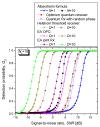Entanglement-Assisted Joint Monostatic-Bistatic Radars
- PMID: 35741476
- PMCID: PMC9221668
- DOI: 10.3390/e24060756
Entanglement-Assisted Joint Monostatic-Bistatic Radars
Abstract
With the help of entanglement, we can build quantum sensors with sensitivity better than that of classical sensors. In this paper we propose an entanglement assisted (EA) joint monostatic-bistatic quantum radar scheme, which significantly outperforms corresponding conventional radars. The proposed joint monostatic-bistatic quantum radar is composed of two radars, one having both wideband entangled source and EA detector, and the second one with only an EA detector. The optical phase conjugation (OPC) is applied on the transmitter side, while classical coherent detection schemes are applied in both receivers. The joint monostatic-bistatic integrated EA transmitter is proposed suitable for implementation in LiNbO3 technology. The detection probability of the proposed EA joint target detection scheme outperforms significantly corresponding classical, coherent states-based quantum detection, and EA monostatic detection schemes. The proposed EA joint target detection scheme is evaluated by modelling the direct radar return and forward scattering channels as both lossy and noisy Bosonic channels, and assuming that the distribution of entanglement over idler channels is not perfect.
Keywords: entanglement; entanglement assisted detection; quantum radars; quantum sensing; radars.
Conflict of interest statement
The author declares no conflict of interest.
Figures









References
-
- Djordjevic I.B. Quantum Communication, Quantum Networks, and Quantum Sensing. Elsevier/Academic Press; London, UK: 2022.
-
- Guha S., Erkmen B.I. Gaussian-state quantum-illumination receivers for target detection. Phys. Rev. A. 2009;80:052310. doi: 10.1103/PhysRevA.80.052310. - DOI
-
- Djordjevic I.B. Quantum Information Processing, Quantum Computing, and Quantum Error Correction: An Engineering Approach. 2nd ed. Elsevier; London, UK: Academic Press; San Diego, CA, USA: 2021.
-
- Cariolaro G. Quantum Communications. Springer International Publishing AG; Cham, Switzerland: Berlin/Heidelberg, Germany: 2015.
-
- Djordjevic I.B. Physical-Layer Security and Quantum Key Distribution. Springer International Publishing AG; Cham, Switzerland: Berlin/Heidelberg, Germany: 2019.
LinkOut - more resources
Full Text Sources

